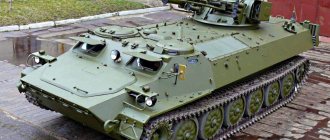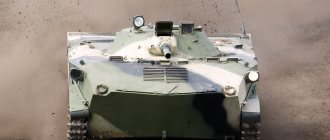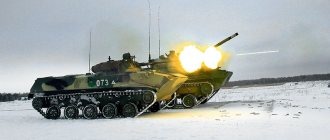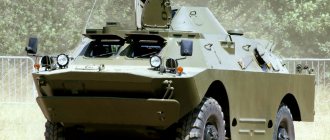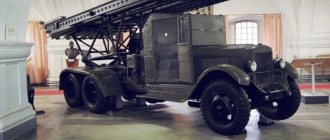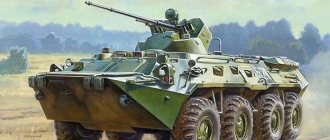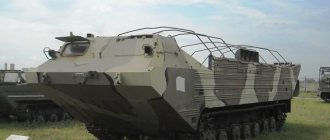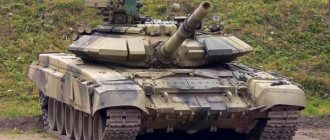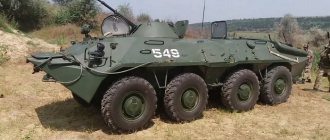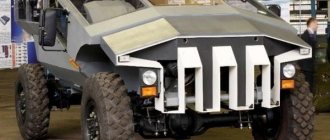BMD is an abbreviation of the phrase “airborne combat vehicle.” Based on the name, the BMD is a vehicle for moving a unit of airborne troops. Its main purpose is to fight enemy armored vehicles and enemy infantry. In professional military circles, this vehicle was called “Budka”.
To carry out its combat mission, the BMD can be transported by military aircraft to the landing site. Landing can be carried out from Mi-26 aircraft and helicopters using an external sling.
How did the BMD-2 airborne combat vehicle appear?
The designers developed the first generation of BMD back in 1969, and after testing it was put into service with the Airborne Forces of the Soviet Union. Serial assembly of the combat vehicle was carried out at the Volgograd Tractor Plant. In the first years it was produced in limited editions. To start serial production, we used the forces of the All-Russia Research Institute of Steel, the Welding Institute named after. E. Paton.
In 1980, Soviet designers, having studied the experience of using BMD in real battles, moved on to improving the existing model. The need to modernize the airborne combat vehicle became obvious after Afghanistan, where the armored vehicle was actively used. Having proven itself well in combat on flat areas, the first generation airborne combat vehicle lost in highlands.
The BMD-2 airborne combat vehicle entered service with the air force of the Soviet Union in 1985. The second generation vehicle did not differ much in appearance from the BMD-1. The comparative photo of the BMD-2 and BMD-1 shows that the changes affected the turret and weapons. The hull and engine remain unchanged. The armored vehicle experienced its baptism of fire in combat operations in the Republic of Afghanistan.
In subsequent years, the BMD-2 was used in armed conflicts in Russia and abroad. Today, the “booth” is in service in the armies of Russia, Kazakhstan and Ukraine.
Object 916K
Also known as the command BMD-2K. This technique was put into service in 1986. First of all, this machine was created in order to ensure reliable and efficient management of units. The BMD-2 was changed internally and externally. Thus, the presence of a second radio station R-173 was envisaged. The R-173P was used as a radio receiver. There is also a second antenna input, which should support information transmission. The apparatus of the BB36 intercom was also duplicated. The command vehicle also has a heater, a GPK-59 direction indicator, an AB-0.5-P/30 gas-electric unit, a PRHR GO-27 chemical and radiation reconnaissance device (it replaced the GD-1M gamma sensor), and an exhaust fan for the middle compartment. Two removable tables were added. To improve the commander's working conditions, a guided missile system was removed from the vehicle. Also, due to the desire to place a charging unit for camping use, the middle rear seat of the machine gunner was removed.
Design features of BMD-2
The design of the airborne combat vehicle is considered unique. In the front part, the driver-mechanic is located in the center, behind him is the commander on the right, and on the left is the gunner. In the rear there is a compartment for troops. It can accommodate 5 paratroopers.
The BMD-2 body is conventionally divided into 4 sections:
- management department;
- combat unit;
- troop squad;
- engine and transmission compartment.
The combat unit and control compartment are combined and are located in the front and middle parts of the armored vehicle. The rear half is divided into troop and engine compartments.
The armored hull is welded from aluminum sheets that cover the BMD-2 crew. The characteristics of this metal make it possible to achieve effective protection with low weight. Armor capable of protecting the crew from bullets, small fragments of mines and shells. The thickness of the body trim in the front part is 15 mm, on the sides - 10 mm. The tower has armor 7 mm thick. The bottom of the BMD is reinforced with stiffening ribs, which allows for successful airborne landings. The minimum landing altitude is 500 meters, the maximum altitude is 1500 meters. In this case, multi-dome parachutes with a PRSM 916 (925) jet system are used.
After modernization, PM-2 received a new circular tower. It is smaller in size. In addition, it gained the ability to fire at helicopters and low-flying aircraft. The vertical guidance angle was increased to 75 degrees.
The BMD-2 body is sealed. This turned the “booth” into a floating armored vehicle. To move through a water obstacle, a water-jet installation is used, the operation of which is based on the principle of jet propulsion. Before moving through a water obstacle, it is necessary to raise the wave protection flap in front. Thanks to the properties of the amphibious vehicle, landing can be carried out from transport ships.
Description of design
The first vehicles began testing in 1984. They were completed successfully and already in 1985 the BMD-2 was put into service. This technique has a welded body. It is made of aluminum armor alloy. This protection makes it possible to ensure the safety of the crew from armor-piercing bullets of 12.7 mm caliber in the frontal projection. This allows you to provide reliable cover from attacks by infantry. The all-round protection is only designed to stop 7.62. The BMD-2 device allows you to increase the crew to 3 people (there is a job for everyone). True, in such cases it is necessary to reduce the number of troops to 4 soldiers. There are three TNPO-170A surveillance devices. They are installed above the driver in front of the hatch. On the outside of the armored vehicle there are headlights, side lights, a sound signal, a wave-reflecting shield, rear and front mud flaps, a radio antenna, jet shutters, tow hooks, mounting parts for landing, a device for transporting cargo using a trailer, as well as two boxes with spare parts , tools and accessories. And little things - a packing device, a shovel, a tarpaulin, a crowbar and an emergency buoy. To maintain communication, a radio station R-173 is provided. It provides the ability to negotiate at a distance of up to 20 kilometers. The whip antenna can reach three meters. To receive signals, radio receivers R-173P and TPU R-174 are usually installed. Although the very first representatives were equipped with R-123M and TPUR-124 devices. The latest vehicles were produced with R-163-50PU radio stations, not R-173. This option made it possible to maintain a stable exchange of digital and analog information in the frequency range from 30 to 80 MHz and at a distance of up to twenty kilometers. At the same time, the possibility of automated transition to the backup frequency was implemented.
Engine and chassis
When creating the BMD-2, engineers did not completely modernize the engine and chassis. The airborne combat vehicle is equipped with a 5D20 engine. This is a diesel engine with 6 cylinders. It is capable of developing a power of 240 horsepower.
BMD-2 uses caterpillar tracks. There are 5 track rollers and 4 rollers on each side. The drive axle is rear, with steering wheels in front. The chassis has a design that allows you to adjust the ground clearance. The minimum ground clearance is 10 cm, and the maximum is 45 cm. The suspension is independent.
Content
- 1 Development
- 2 Description 2.1 Overview
- 2.2 Crew
- 2.3 Tower
- 2.4 Armament
- 2.5 Maneuverability
- 2.6 Airdrop methods
- 2.7 Amphibian
- 2.8 Armor protection
- 2.9 Troop squad
- 2.10 Equipment
- 3.1 War in Donbass
- 5.1 Current operators
BMD 2. Characteristics of weapons
The modernization of the airborne combat vehicle in the 80s mainly affected the turret and weapons. The military experience in Afghanistan forced us to reconsider the fire arsenal.
The main firepower is the 2A42 30mm automatic cannon. She is capable of shooting while moving. The barrel is stabilized in two planes using an electro-hydraulic weapon stabilizer 2E36-1. In the roof of the turret there is the main sight VPK-1-42, which aims the gun. The “booth” is capable of firing at a range of up to 4 kilometers.
Paired with the cannon in the turret is a 7.62 mm PKT machine gun. The combat kit of the second generation BDM consists of 300 shells for a cannon and 2000 rounds for a machine gun.
Additional weapons for the BMD-2 can be used to enhance firepower. The operating instructions determine the composition of additional weapons:
- one 9M113 “Competition”;
- two 9M111 “Fagot” ATGMs;
- launcher 9P135M.
Missile launchers are capable of aiming within 54 degrees horizontally and from -5 to +10 vertically.
To conduct successful combat with air targets, the Igla and Strela-2 missile systems were introduced into the armament.
Description[edit]
Review[edit]
Main article: BMD-1 § Review
The BMD-2 has a slightly modernized BMD-1 hull and a new turret.
Crew[edit]
Main article: BMD-1 § Crew
The BMD-2 crew is the same as on the BMD-1, with minor changes such as the fact that the commander no longer uses the left nose 7.62 mm PKT tank machine gun, which was removed because testing showed it too exhausted. Its main duties are to shoot it accurately. He was also given a radio station R-123M for communication.
The new turret places the gunner to the left of the main gun. At the top of the turret there is a solid round hatch that opens forward. In front of this hatch there is a gunner's sight, the same as on the BMP-2. Another gunner's sight is located on the left side of the main gun and moves in vertical planes with it. This is a sight with a high angle of sight, which is used when aiming the gunner at aerial targets. The vehicle also has additional periscopes that provide visibility to the sides. There is a white spotlight installed in front of the tower. [ citation needed
]
Turret[edit]
The B-30 turret is a modified version of the BMP-1/BMD-1 turret.
Weapons [edit]
BMD-2 106th Guards Airborne Division
The vehicle is armed with a stabilized 30-mm 2A42 multi-purpose autocannon and a coaxial 7.62-mm PKT tank machine gun (mounted on the right side of the main gun). The vehicle carries 300 rounds for the main gun (180 armor-piercing and 120 fragmentation rounds) and 2,940 rounds for the machine gun. The main gun can be raised or lowered between 75° and -5° and can be used to fire at aerial targets. The turret is also equipped with a 9P135M-1 ATGM pin launcher on the right side of the turret roof with semi-automatic control, capable of firing SACLOS under the control of 9M113 "Konkurs" (AT-5 Spandrel), 9M113M ". "Konkurs-M" (AT-5B Spandrel B), 9M111 "Bassoon" (AT-4 fitting) and 9M111-2 "Bassoon" (AT-4B Spigot B).
Maneuverability [edit]
Main article: BMD-1 § Maneuverability
The BMD-2 has the same engine and suspension as the BMD-1, but has a maximum road range of 450 km.
Airdrop technique[edit]
BMD-2 after landing
The vehicle can be transported by An-12, An-22, Il-76, An-124 aircraft, Mi-6 and Mi-26 helicopters.
The PRSM-915 rocket parachute was designed to ensure a safe landing of the vehicle. [3] To use a parachute, the BMD is first packed on a special pallet before takeoff. To release the BMD, a braking parachute is released, which initially pulls the BMD out of the Il-76 transport aircraft. When leaving the plane, a single large main chute opens. Deployment of the main chute causes the deployment of four long rods that hang below the tray. As soon as the rods touch the ground, the retractor is activated, slowing the BMD to a descent speed of 6 to 7 m/s and providing a relatively soft landing. [4]This made it possible to relatively safely lower the BMD with a parachute with both the driver and the gunner. This system entered service in 1975 for the BMD-1, and was subsequently always used for the BMD-2.
Amphibian[edit]
| In this section do not cite any sources . |
Main article: BMD-1 § Landing capabilities
The BMD-2 is fully amphibious, it can float after turning on two electric bilge pumps, installing a two-section trimmer blade, which improves the stability and displacement of the vehicle in the water, and also prevents the bow of the tank from flooding with water and switching the driver's periscope. for a swimming periscope, which allows the driver to see through the trimmer.
Armor protection [edit]
The thickness of the aluminum armor is 7 mm on the turret, 15 mm on the front of the hull and 10 mm on the rest of the hull. The frontal armor of the hull has two sections: upper and lower. The top part is at an angle of 78° and the bottom is at an angle of 50°. It is resistant to small arms fire and shrapnel.
Troops squad [edit]
Rear view of BMD-2
The design was made to save necessary weight and sacrifice crew comfort. [5] Like the BMD-1, the BMD-2 has extremely limited internal space. It is much smaller than that of the BMP-1 and BMP-2. It can carry five infantrymen, including a vehicle commander, a machine gunner and three soldiers sitting behind the turret.
It is equipped with periscope viewing units on the sides and rear of the vehicle. Additionally, there are only three firing ports, two on each side of the hull and one at the rear. [5]
Equipment [edit]
Main article: BMD-1 § Equipment
The BMD-2 is equipped with the same equipment as the BMD-1, with the exception of the R-123 radio, replaced by the R-123M radio.
Equipment of an airborne combat vehicle
The BMD-2 is equipped with an R-174 trouser communication device and an R-123 radio station (later it was replaced by the R-123M).
In addition, on board the armored vehicle there is:
- automatic fire extinguishing complex;
- system for air filtration and exhaust;
- system of protection against weapons of mass destruction and atomic weapons;
- chemical weapons protection system;
- night-vision devices;
- air ventilation system inside the body of a combat vehicle.
About missile weapons
The technical description of the BMD-2 is incomplete without the icing on the cake. This is the 9K111 guided missile system. It is designed to destroy tanks, as well as other mobile armored objects that move at speeds of up to 60 kilometers per hour. This complex can also be used to strike stationary targets such as long-term fire installations. The possibility of hitting hovering helicopters is also provided. But only if their optical visibility is up to four thousand meters. The 9P135M is used as the launcher for the complex. It can fire 9M113 Konkurs and 9M111-2 Fagot anti-tank guided missiles. The first ATGM is issued in the amount of one missile, and the second - two pieces. Only three units. The missiles are located in the port side stowage. To guide an ATGM over a wire line, ground control equipment is used, namely 9S451M.
Technical characteristics of the "Booth"
During the battle, the “booth” is capable of overcoming various obstacles. Without difficulty, the BMD-2 airborne combat vehicle can drive onto a wall 80 centimeters high and overcome a trench 1.6 meters wide.
| Performance characteristics of BMD-2 | |
| Weight | 8.22 tons |
| Length with gun | 5.91 meters |
| Width | 2.63 meters |
| Height depends on ground clearance | from 1615 to 1965 millimeters |
| Fuel tank capacity | 300 liters |
| Operational range | 450-500 kilometers |
| Maximum speed: track rugged terrain water hazard | 80 km/h 40 km/h 10 km/h |
What are they shooting at?
To consider the weapons of the BMD-2 without paying due attention to the ammunition used is to go very superficially. The gun can use high-explosive fragmentation incendiary and armor-piercing tracer shells. Its ammunition is designed to combat lightly armored targets, such as armored personnel carriers or infantry fighting vehicles. It can also be used to suppress firing points at a distance of up to 2000 meters. In addition, the gun is effective for combating unarmored ground targets and defeating manpower. And to top it all off, it can destroy low-flying air targets moving at subsonic speeds. Ammunition supply is two-belt. They are formed from individual links and are intended to be placed in stores. There are two compartments. In the front there is a belt designed for 100 armor-piercing tracer shells. The rear compartment holds 200 rounds of high-explosive fragmentation and incendiary ammunition. Now to the PCT. There are only two of them. One of the machine guns is paired with a cannon. The second is located in the heading position on the starboard side. Both machine guns are designed to use 7.62x54.
